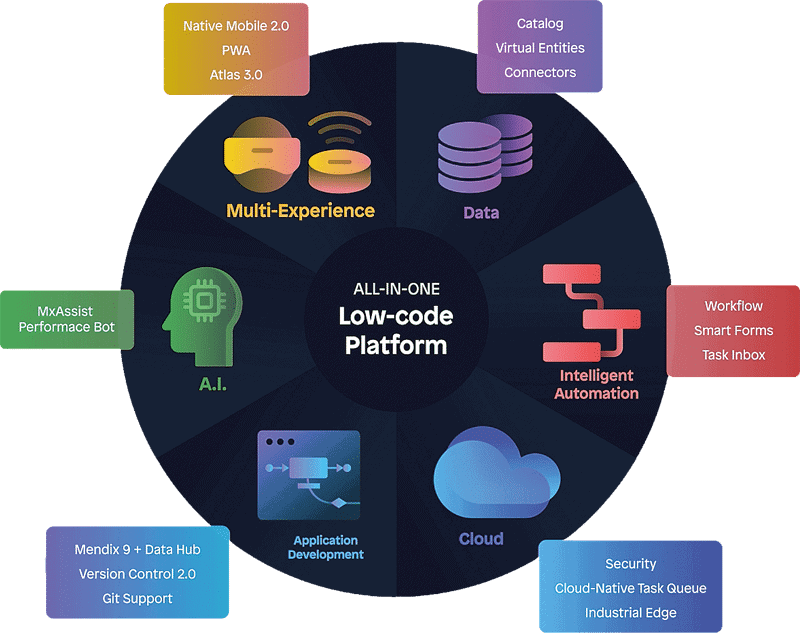Rationalization and Automation


Low-code technology no longer just speeds up app development
Global companies across all business sectors are expected to spend more than $10 trillion on digital transformation initiatives, but more than 70 percent will fail. According to Mendix, a Siemens subsidiary and a leader in the development of modern enterprise applications, companies across all business sectors will need to dramatically change their approach to digital transformation to remain relevant in today's highly accelerated, digitally-focused business world. Research shows that some companies have understood the "Go Digital or Go Dark" message.
Composable Thinking
Transforming the enterprise with internal talent that can leverage their digital expertise in response to market changes makes any business model resilient. The next element for competitive advantage in the accelerated digital-first economy is the adoption of Composable Thinking across the enterprise.
Simply put, "composability" means that companies use pre-built software modules or digital components (for example, templates or packaged business services) and assemble them into a targeted solution. This approach can dramatically reduce effort and shorten time to value. Often, employees, key partners, independent software vendors, and customers can provide these easily customizable templates or packaged features that accelerate the digitization process. The ability to find or deliver value-added features breaks the stalemate between commercial off-the-shelf software that cannot be customized and the expensive endeavor of developing highly targeted, high-code software.
"Enterprises can implement digital solutions much faster by composing and adapting these resources from an ever-expanding ecosystem of proven sources," Van Huizen said. This approach, which Gartner calls the "composable enterprise," is the final element for successful digital transformation. It enables companies to become agile and scale, quickly adapt to changing market conditions or disruptions, meet evolving customer needs, and seize opportunities with new lines of business.
Van Huizen concludes, "A compositional approach combines creative solutions from as large a community as possible with the targeted needs of the business. In this way, innovation becomes a continuous activity throughout the company, every day."
IDC predicts that enterprise spending on digital transformation initiatives will exceed $10 trillion within five years. A study by PwC found that 60 percent of top executives cite digital transformation as the most important factor for business growth in 2022. The Boston Consulting Group reports that 80 percent of companies intend to accelerate their planned digital transformation initiatives.
Digital transformation
Despite these activities, in practice it is proving difficult to accelerate the strategic introduction of new technologies to meet operational requirements, achieve efficiencies, develop new areas of business, and provide enhanced, innovative experiences for customers and employees.
Boston Consulting Group analysts recently calculated that 70 percent of all enterprise digitization efforts fail. McKinsey found that 87 percent of companies have a digital skills gap, making it difficult to quickly implement business-critical, innovative solutions.
Successful digital transformation is best supported by an open digital business platform that is flexible, interoperable and collaborative to accelerate value creation and innovation at scale. To achieve this, companies should start with an enterprise-wide focus on strategic planning that includes clear and concise execution and success metrics. It is a holistic process that transforms the digital transformation paradigm from a series of disjointed individual initiatives into a continuous practice.
This type of structured approach requires companies to conduct a thorough self-assessment of their digital maturity and application landscape. This is the foundation for creating a scalable roadmap that identifies how to develop a change-ready culture, demonstrate progress on business-critical objectives, and gain buy-in across the enterprise. Without this alignment, fundamental barriers such as risk aversion and resistance to change arise from the disconnect between strategic vision and execution, torpedoing all but 30 percent of digital transformation projects.

Business Case
"The fundamental premise of digital transformation is to create the future without the restrictions of the past. Innovation happens not only by creating something completely new, but also by improving what already exists," says Nick Ford, chief marketing officer at Mendix. "It's no surprise that most companies are trying to use technology to kick-start this process. That's important, but the key to success starts with people - the makeup of the team, the company culture, the business case and product vision, deadlines and risk factors. At Mendix, we describe how digital transformation begins with a holistic self-assessment of a company's people, portfolio, processes and platform. This means that a single initiative - no matter how brilliant - if executed by a team working in isolation and signed off by the most well-meaning stakeholders, will not result in transformative benefits."
For a growing majority, low-code platforms play a critical role in streamlining and automating operations and digitizing customer experiences. Low-code today enables companies to change their business models to succeed in the digital marketplace, harness data for multiple purposes, and integrate next-generation technologies into core systems. To illustrate this trend, Gartner reports that by 2025, approximately 70 percent of all new applications will be built using low-code tools. Low-code development encourages continuous collaboration between business and IT. Better communication between these areas significantly reduces rework and backlogs in IT projects. Such efforts pay off. Researchers have found that companies that lead in the area of digitization achieve 1.8 times higher profit growth than companies that lag behind in the area of digitization.
Low-code provider
Not surprisingly, hundreds of low-code vendors have entered the market to capitalize on this pressing need. But to reap the benefits of digital transformation, enterprises need to be sure that a low-code platform supports digital solutions without compromising the architecture, and that it meets specific cloud deployment and DevOps requirements. The right platform will also enable more of the company's staff - not just from the IT department - to be dedicated to solution development. Finally, the platform should be able to handle a variety of use cases that require both data-centric and process-centric approaches.
Man and machine
Even best-in-class technology alone is not enough. It's critical to harness the human power of fusion teams that include both business and IT experts to leverage technology to achieve business goals. A common stumbling block is when "companies do too much at once, launching big, ambitious projects and investing in technology to quickly build a digital infrastructure," says Gordon Van Huizen, vice president, platform strategy at Mendix. Such approaches, while ambitious, lead to disparate efforts that don't produce the results hoped for. Instead, Van Huizen recommends focusing on specific use cases first. This iterative selection is the natural outcome of an enterprise-wide digital maturity assessment.




